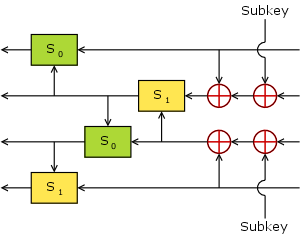
The Data Encryption Standard is a symmetric-key algorithm for the encryption of digital data. Although its short key length of 56 bits makes it too insecure for modern applications, it has been highly influential in the advancement of cryptography.
Differential cryptanalysis is a general form of cryptanalysis applicable primarily to block ciphers, but also to stream ciphers and cryptographic hash functions. In the broadest sense, it is the study of how differences in information input can affect the resultant difference at the output. In the case of a block cipher, it refers to a set of techniques for tracing differences through the network of transformation, discovering where the cipher exhibits non-random behavior, and exploiting such properties to recover the secret key.
In cryptography, linear cryptanalysis is a general form of cryptanalysis based on finding affine approximations to the action of a cipher. Attacks have been developed for block ciphers and stream ciphers. Linear cryptanalysis is one of the two most widely used attacks on block ciphers; the other being differential cryptanalysis.
Articles related to cryptography include:
In cryptography, Lucifer was the name given to several of the earliest civilian block ciphers, developed by Horst Feistel and his colleagues at IBM. Lucifer was a direct precursor to the Data Encryption Standard. One version, alternatively named DTD-1, saw commercial use in the 1970s for electronic banking.
In cryptography, Skipjack is a block cipher—an algorithm for encryption—developed by the U.S. National Security Agency (NSA). Initially classified, it was originally intended for use in the controversial Clipper chip. Subsequently, the algorithm was declassified.

The GOST block cipher (Magma), defined in the standard GOST 28147-89, is a Soviet and Russian government standard symmetric key block cipher with a block size of 64 bits. The original standard, published in 1989, did not give the cipher any name, but the most recent revision of the standard, GOST R 34.12-2015, specifies that it may be referred to as Magma. The GOST hash function is based on this cipher. The new standard also specifies a new 128-bit block cipher called Kuznyechik.

In cryptography, DES-X is a variant on the DES symmetric-key block cipher intended to increase the complexity of a brute-force attack. The technique used to increase the complexity is called key whitening.
In cryptography, Khufu and Khafre are two block ciphers designed by Ralph Merkle in 1989 while working at Xerox's Palo Alto Research Center. Along with Snefru, a cryptographic hash function, the ciphers were named after the Egyptian Pharaohs Khufu, Khafre and Sneferu.
In cryptography, LOKI89 and LOKI91 are symmetric-key block ciphers designed as possible replacements for the Data Encryption Standard (DES). The ciphers were developed based on a body of work analysing DES, and are very similar to DES in structure. The LOKI algorithms were named for Loki, the god of mischief in Norse mythology.
In cryptography, the eXtended Sparse Linearization (XSL) attack is a method of cryptanalysis for block ciphers. The attack was first published in 2002 by researchers Nicolas Courtois and Josef Pieprzyk. It has caused some controversy as it was claimed to have the potential to break the Advanced Encryption Standard (AES) cipher, also known as Rijndael, faster than an exhaustive search. Since AES is already widely used in commerce and government for the transmission of secret information, finding a technique that can shorten the amount of time it takes to retrieve the secret message without having the key could have wide implications.
In cryptography, REDOC II and REDOC III are block ciphers designed by Michael Wood (cryptographer) for Cryptech Inc and are optimised for use in software. Both REDOC ciphers are patented.

In cryptography, the boomerang attack is a method for the cryptanalysis of block ciphers based on differential cryptanalysis. The attack was published in 1999 by David Wagner, who used it to break the COCONUT98 cipher.
Introduced by Martin Hellman and Susan K. Langford in 1994, the differential-linear attack is a mix of both linear cryptanalysis and differential cryptanalysis.
In cryptography, impossible differential cryptanalysis is a form of differential cryptanalysis for block ciphers. While ordinary differential cryptanalysis tracks differences that propagate through the cipher with greater than expected probability, impossible differential cryptanalysis exploits differences that are impossible at some intermediate state of the cipher algorithm.
In cryptography, COCONUT98 is a block cipher designed by Serge Vaudenay in 1998. It was one of the first concrete applications of Vaudenay's decorrelation theory, designed to be provably secure against differential cryptanalysis, linear cryptanalysis, and even certain types of undiscovered cryptanalytic attacks.
In cryptography, the Davies attack is a dedicated statistical cryptanalysis method for attacking the Data Encryption Standard (DES). The attack was originally created in 1987 by Donald Davies. In 1994, Eli Biham and Alex Biryukov made significant improvements to the technique. It is a known-plaintext attack based on the non-uniform distribution of the outputs of pairs of adjacent S-boxes. It works by collecting many known plaintext/ciphertext pairs and calculating the empirical distribution of certain characteristics. Bits of the key can be deduced given sufficiently many known plaintexts, leaving the remaining bits to be found through brute force. There are tradeoffs between the number of required plaintexts, the number of key bits found, and the probability of success; the attack can find 24 bits of the key with 252 known plaintexts and 53% success rate.
This article summarizes publicly known attacks against block ciphers and stream ciphers. Note that there are perhaps attacks that are not publicly known, and not all entries may be up to date.

Orr Dunkelman is an Israeli cryptographer and cryptanalyst, currently a professor at the University of Haifa Computer Science department. Dunkelman is a co-director of the Center for Cyber Law & Privacy at the University of Haifa and a co-founder of Privacy Israel, an Israeli NGO for promoting privacy in Israel.





